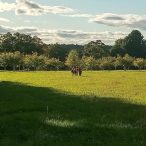Bioblitz returns to the Blackstone Valley in Cumberland
So what is a bioblitz? As defined by Rhode Island Natural History Survey (RINHS):
“A BioBlitz is an attempt by volunteers, working scientists and avocational naturalists, to tally as many species of organisms as they can in 24 hours on a particular parcel of land. It is designed to bring the community of naturalists together, to demonstrate the biodiversity that surrounds us on even the most mundane-looking land, and the value of these species to the quality of our lives.”
Bioblitz is a national and international occurrence. Rather than a formal field study that involves only scientists and biologists, a bioblitz encourages community members, families, and students to get involved and take an interest in biodiversity.
Most importantly bioblitz is just a fun way to learn about the habitat and species diversity near where you live or visit. We love to say we are off to go blitzing.
The first community bioblitz to include community members occurred in 1997 at Pittsburgh, Pennsylvania’s Riverview Park. LEARN MORE
In Rhode Island, the RINHS organized the first RI Bioblitz in June 2000 at Roger Williams Park with 33 volunteers. They observed 663 species.
The first bioblitz in the Blackstone Valley was in 2006 and Blackstone Valley Tourism Council participated as an educational partner at The Monastery in Cumberland. It was rainy, but folks still had fun and 77 scientists and volunteers turned up to scour the 500 acres in search of diversity. The highlights were a confirmed presence of American larch and a rare lichen. MORE INFO
This year bioblitz returned to the Blackstone Valley at Mercy Woods in Cumberland, managed by the Cumberland Land Trust, who also served as hosts along with the town of Cumberland. Mercy Woods is a fantastic piece of land with several hiking trails and varied terrain. Generally held in June, due to COVID, this is the first bioblitz to take place in fall.
Start of the bioblitz began at 2 pm Friday, and by the time we arrived at 4 pm, there was already an amazing collection of mushrooms (fungi) on display at science central.
Here are some highlights of the afternoon.
Look at all those mushrooms!
This is a great opportunity for students of all ages.
The dinner bell rang at 5:30 pm with our friends from Cumberland Land Trust. Catered locally by Mickey G’s Clam Shack, we learned that Micky G’s does more than just clamcakes and chowder. The eggplant parm was delicious!
As dinner came to a close the camaraderie around this event was evident. We learned from some plant experts that we found some Bittersweet and Autumn Olive (both invasive plants) on our investigation along one of the trails.
When the sun had set and dusk followed, volunteers continued their search for biodiversity in the hopes of finding owls, bats and other night critters.
Saturday at 2 pm David Gregg, Executive Director of RINHS closed the event by blowing his horn, customary with every bioblitz. So far the preliminary species count is at 589, with more precise numbers by Friday. Visit RI Natural History’s Facebook Page
This was the third bioblitz in the Blackstone Valley. Besides the 2006 bioblitz and this year’s bioblitz, RINHS also hosted a bioblitz at Sprague Farm in Glocester in June, 2009. There were 119 participants that identified 1013 species of plants and animals. MORE INFO
As you can see, Blackstone Valley is quite diverse. If you are interested in learning more about the Rhode Island Natural History Survey and how you can get involved with the RI Bioblitz or maybe even know of a site that would benefit from a bioblitz, visit their website. https://rinhs.org/
Now that you’ve learned a little more about the diversity of various species of wildlife and plants you can discover in Rhode Island’s Blackstone Valley, come find them for yourself.
Here’s a listing of where you can hike & bike. Let us know what you find!
